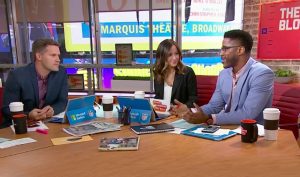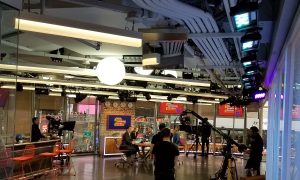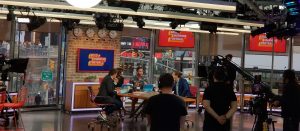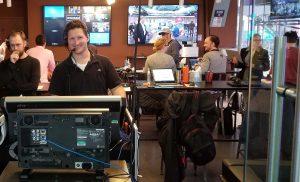NFL Network Takes At-Home Approach to New Good Morning Football Studio in Times Square
Located at the NFL Experience, the facility accesses a control room at NFL Films’ Mt. Laurel HQ
Story Highlights
NFL Network’s Good Morning Football christened its brand-new home last week, moving into a new studio at the NFL Experience Times Square. Although the 40,000-sq-ft. interactive football destination in the heart of New York City provided the perfect location for the NFL Network morning show in terms of style and branding, the limited amount of space available at the facility (which is operated by Cirque du Soleil) and a short timeline for launch made it one of the more unusual studio projects in recent memory.
“Our goal was to balance the central location of Times Square and all of the great attractions of NFL Experience with the basic elements required for the content of the show, including live news hits, breaking down the game, and all of the fun pieces,” says NFL Media VP, Production, Dave Shaw. “Working with the NFL Experience and Cirque team has been terrific: both of us see why this move made so much sense. Undoubtedly, we both are space-challenged, and we did not want to impact their day-to-day operation. But doing a show of this magnitude [requires significant] space, for sure.”

NFL Network’s Good Morning Football and its hosts (from left) Kyle Brandt, Kay Adams, and Nate Burleson moved into its new Times Square digs on May 14.
The move from CBS Studios to the NFL Experience was approved in November, and NFL Media quickly went to work to make the May 14 planned launch date. Given the limited footprint available at the NFL Experience, NFL Media opted to run the studio out of an existing control room at NFL Films headquarters in Mt. Laurel, NJ. In addition, the space used for the studio doubles as a cafeteria area once the Experience opens each day, which means that NFL Media must strike the studio in less than an hour each day following the conclusion of Good Morning Football.
“We set a very tight timeline, and we were able to keep to it. We’re very proud of that,” says NFL Media VP, Engineering, Bruce Goldfeder. “We knew that space would be a challenge and that we would have to think outside the box a bit, but this was a real group effort between NFL Media and NFL Films. Everybody took ownership of their little areas and made it all happen.”
At-Home Workflow in Action: From Times Square to Mount Laurel
Right from the outset, NFL Media knew that building out a control room onsite at NFL Experience was not a viable option. And, with a fully equipped control room in Mt. Laurel that wasn’t being used, the decision to produce the show from NFL Films HQ quickly became apparent. To meet the needs of GMF, the NFL Films engineering team added encoding/decoding infrastructure and multiviewers and expanded its routing infrastructure and camera RCPs in order to shade the studio cameras remotely.
“From the start, we knew [locating the control room in Times Square] was not practical,” notes Goldfeder. “Plus, we had a control room that wasn’t really being utilized in Mount Laurel. All we really had to do was augment the incoming and outgoing feeds and add the camera-shading positions. Besides that, we are pretty much using the existing control room and facilities.”

NFL Network’s Good Morning Football set is broken down completely after each show to make way for the cafeteria area at the NFL Experience.
NFL Media originally established fiber connectivity between NFL Experience and its Culver City, CA, headquarters via RCN to home-run cameras for occasional news hits. Once the decision was made to launch the full GMF studio in Times Square with the control room in Mt. Laurel, NFL Media enlisted The Switch to expand the fiber backbone to 10 GBps and provide Net Insight J2K NIMBRA service for multiple camera feeds, comms, two-ways, multiviewer returns, and so on. The studio now has full connectivity to both NFL Films in Mt Laurel and NFL Media in Culver City.
According to Shaw, the remote setup at Times Square is similar to NFL Media’s at-home productions at recent Super Bowls and NFL Drafts: multiple camera signals, comms, and tallies are multiplexed, and return video is transported via single fibers between facilities.
Although the new GMF studio served as the catalyst for the overall project, NFL Media and NFL Films operations have also benefited significantly. In addition to boosting the East Coast presence of NFL Network, the NFL Films studio has been rebuilt and redesigned (with Jack Morton Worldwide) to handle multiple shows. In addition, the project has enhanced the overall coordination between graphics, news, and production operations.
“While this move is fantastic for the content location for Good Morning Football and assists in building and promoting the amazing world of NFL Experience, it certainly helps us at NFL Media in L.A. to have a staff crew doing a live daily show on the other side of the country,” says Shaw. “This move has provided our entire team confidence in our workflows that we can prepare for any potential threats to our respective facilities.”
Constructing the Studio: Every Inch Counts
The primary challenges that NFL Media faced at Times Square were limited space, power, and fiber infrastructure. Despite the limited footprint, the team was able to work with NFL Experience to create space for a small rack room, a props-storage space, and a combo green room/makeup/meeting space, which included building walls and utilizing every inch possible.

NFL Media utilized every possible inch of space in building out the studio, a rack room, and storage space at its NFL Experience studio.
Goldfeder and his team worked with CP Communications at its Wappingers Falls, NY field shop to build the necessary equipment infrastructure, which later was moved into place at the NFL Experience as soon as walls and power were in place.
“One of the biggest challenges was building the facility while they were still operating the NFL Experience,” says Goldfeder. “We could only work from 8 p.m. to 10 a.m., so we broke up the shifts with construction and scenics done in the evening, and our team would come in at about 5 a.m. and pull cable until they opened the doors at 10 a.m. Plus, we had to coordinate with the NFL Films people on that schedule. It was a tough schedule, but we’re very happy with how it turned out.”
A Studio at the Crossroads of the World
The GMF studio features an exposed-brick wall and multiple LED displays and looks out onto the heart of Times Square on 42nd Street. The main desk — a simple wood table with a silver NFL shield emblazoned on it — is manned by hosts Kay Adams, Nate Burleson, Peter Schrager, and Kyle Brandt.
One of the bigger challenges NFL Media encountered was the excessive glare and reflection caused by the multitude of LED displays in Times Square. To nullify this effect while preserving the Times Square backdrop, Goldfeder and his team installed Rosco polarizing film on the windows and rotary mounts for the lenses of all five cameras. As a result, each camera has a filter in front of the lens that can adjust the outside-light exposure without affecting the talent’s lighting inside the studio.
The set features five cameras: three hard cameras, one handheld (with optional Steadicam rig), and a custom mini-jib specially designed by Chuck Goslin’s JitaCam group. The jib needed an arm long enough to be effective on the show but also must be quickly struck following each show. In response, the JitaCam team designed a system that can be hoisted into the ceiling in just 15 minutes and stored there. This jib can move around the entire desk in the studio, adding a dynamic look to the coverage.

A small “video village” is set up each day for Good Morning Football, and then the equipment is cleared stored after the conclusion of the show.
Nearly every piece of equipment and set element features a modular design and flexibility to allow ultra-fast setup and strike.
“Every day,” says Goldfeder, “the show ends at 10, and, before 11, everything is totally changed out and gone — the desk, the furniture, the sets, the intercoms, the [equipment] carts — and the space turns into a cafeteria for NFL Experience. That fact that we can make it out in an hour is pretty amazing.”
As its second week at the new studio winds down, further integration between GMF and the NFL Experience will continue, including additional fiber and camera drops throughout the NFL Experience to allow the GMF team to produce live segments from the interactive exhibition.
“We are thrilled to take Good Morning Football to Times Square, not only the best backdrop in the business but one of the most iconic places in the world,” said Mark Quenzel, SVP, programming and production, NFL Media, just prior to studio opening. “With an outstanding cast and crew, Good Morning Football is distinguishing itself in the ultra-competitive morning-TV space, and the opportunity to combine the show with NFL Experience Times Square — two properties that celebrate football and fans year-round — makes a lot of sense.”
